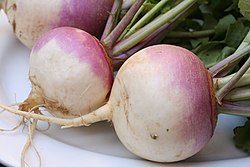This article needs additional citations for verification .(July 2024) |

Root vegetables are underground plant parts eaten by humans or animals as food. In agricultural and culinary terminology, the term applies to true roots, such as taproots and root tubers, as well as non-roots such as bulbs, corms, rhizomes, and stem tubers. [1]




